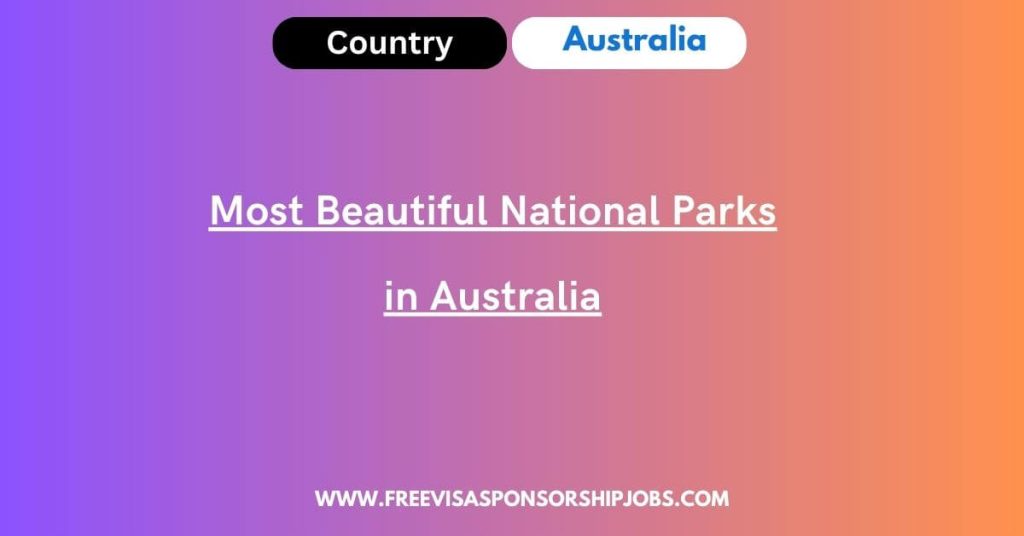Most Beautiful National Parks in Australia

Most people have to take a long trip to get to faraway Australia. You can use the time to rest since you’ll need to get going right away if you want to see the country’s national parks.
More than 500 state parks can be found in Australia. Each has its unique features, such as amazing rock formations made of limestone and sandstone, beautiful beaches, stunning scenery, and a wide range of plants and animals, including the famous kangaroos and dingoes. Here’s a look at some of Australia’s best public parks:
List of Most Beautiful National Parks in Australia:
Nambung National Park
Nambung National Park is another place with great rock formations and ocean views. Only these rock structures, some of which are 3.6 billion years old, are not in the water. They are in the Pinnacles Desert, which is right next to the water.
Thousands of pinnacles, or towers, rise from the yellow sand near the Indian Ocean. Some are short and fat, while others are thin and tall. There are 176 different kinds of animals here, so you might see grey or red kangaroos, dingoes, or even humpback whales when they are migrating. Take a walk on the beach at Kangaroo Point in Western Australia.
Daintree National Park
The oldest jungle in the world is in Daintree National Park. It is a beautiful place to visit. The park is in the far north of Queensland and has plants and animals that can’t be found anywhere else on Earth. All year long, it rains a lot in Daintree National Park, but it rains even more during the summer monsoon season, so plan your trip carefully.
If you can avoid the summer floods, you might see box jellyfish, which are most active in the coastal waters at this time of year. This is also the best time to swim in freshwater holes because they are full and clean.
Port Campbell National Park
Port Campbell National Park is the place to go if you want to see beautiful ocean views and amazing rock formations. The waves of the Southern Ocean shaped these beautiful limestone rock formations, which have names like the Twelve Apostles, Loch and Gorge, and London Bridge.
Since the park is on Victoria State’s Shipwreck Coast, it is also a good place to learn about old shipwrecks. You can walk the Discovery Walk or drive the Great Ocean Road to see the sights. There is a lot of flora, like flowers, and wildlife, like peregrine falcons, here.
Cradle Mountain-Lake St Clair NP
Cradle Mountain-Lake St. Clair National Park on the island of Tasmania is a great place to jump right into the wild. From Cradle Mountain in the north to Lake St. Clair in the south, the park has a wide range of settings, from rainforests to alpine mountains.
Hikers will enjoy the famous six-day Overland Track, which goes through beautiful mountain scenery. However, hikers have to pay a fee to do this trip, which is run by the parks service. The park is one of the most visited natural places in Tasmania because it has such beautiful scenery.
Great Sandy National Park
If you want to see dingoes in Australia, you should go to the world’s biggest sand island, Fraser Island, which is in Queensland’s Great Sandy National Park. On the island, the animals that sound like dogs and howl are protected species.
Humans can get hurt if they don’t follow park safety rules. Aside from dingoes, the park has a lot of different things, like beaches, swamps, rain forests, mangrove forests, and many different kinds of birds. Take the five-day Coolpola Great Walk or a tour by car. Rough terrain makes 4WD cars the best choice.
Kosciuszko National Park
The southern part of New South Wales has a park called Kosciuszko National Park, which is beautiful. Mountains mirrored in clear glacial lakes look like they belong on a postcard. This is, after all, the land of the Snowy Mountains and the Murray River. Mount Kosciuszko is the highest hill on mainland Australia, and Cabramurra is the highest town in the country. Both are in the park.
Aboriginal people have lived in the park for about 20,000 years, and the southern corroboree frog can only be found there. Tourists can ski there in the winter, and in the summer, they can go camping or horseback riding.

Uluru-Kata Tjuta National Park
Many people who go to Uluru-Kata Tjuta National Park in Australia may know it better by its old name, Ayers Rock. When Australia’s most famous natural feature was given back to its original owners, the name was changed to reflect its aboriginal roots.
It is the sacred heart of the native peoples of the area. Uluru is a huge rock made of sandstone that rises out of the Central Australian desert in the Northern Territory. There are 32 rock domes in the Kata Tjuta part of the park. This is the place to be if you want to take beautiful pictures of sunrise and sunset when the rocks change color.
Read More: Best Things to Do in Birmingham AL
Freycinet National Park
Freycinet National Park is the oldest park in Tasmania. It is where the Hazards, which are rough pink and red granite rocks, rise out of the sea. The beautiful blue waters of Wineglass Bay, which is thought to be one of the best beaches in Australia, are below the rock formations.
If you are looking for rare plants and animals (this is a good place for birdwatchers), you may come across aboriginal sites. Some parts of the park are so far away that people have never been there. People come here to kayak, fish, look for shells on the beach, and do other water activities.
Purnululu National Park
When it comes to views, flying over Purnululu National Park is the best way to see it. When you fly over the park’s Bungle Bungle Range, you can see amazing beehive-shaped karst sandstone rocks with orange and black stripes. Just so you know, Bungle Bungle is a native name that means “sandstone.” Some of the largest sandstone mounds in the world can be found here.
Purnululu, in Western Australia, is a great place to go hiking. If you want to camp there, you’ll need to bring food with you, because there’s nothing there. Only 4WD cars can access some parts of the park. This is because the terrain is rough but beautiful.
Kakadu National Park
Kakadu National Park might be the only place on earth where you can see both crocodiles and native rock art. Aboriginal people have lived in the area for about 40,000 years, and their rock art can be found in about 5,000 places.
Kakadu is in the Northern Territory. It has many different kinds of landscapes, plants, and animals, like kangaroos and giant crocodiles. The Alligator River runs through the park. It is about half the size of Switzerland and is Australia’s biggest national park. Ranger Uranium Mine, one of the most productive in the world, is in the park.
Frequently Asked Questions:
-
What is the most visited national park in Australia?
This famous park in Australia used to be called Ayers Rock, but in 2002, the name was changed to Uluru-Kata Tjuta to honor its native history.
-
What is the second-largest national park in Australia?
It is about the size of Wales or one-third the size of Tasmania. It is Australia’s second-largest national park, after the Munga–Thirri–Simpson Desert National Park.
-
What is the smallest national park in Australia?
Pulu Keeling National Park, regardless of being one of the most modest national parks in Australia, holds significant global importance. It is a solitary coral atoll that is part of the Cocos (Keeling) Islands, the most distant island territory in Australia, situated in the Indian Ocean nearly 2,000 kilometers northwest of Perth.




